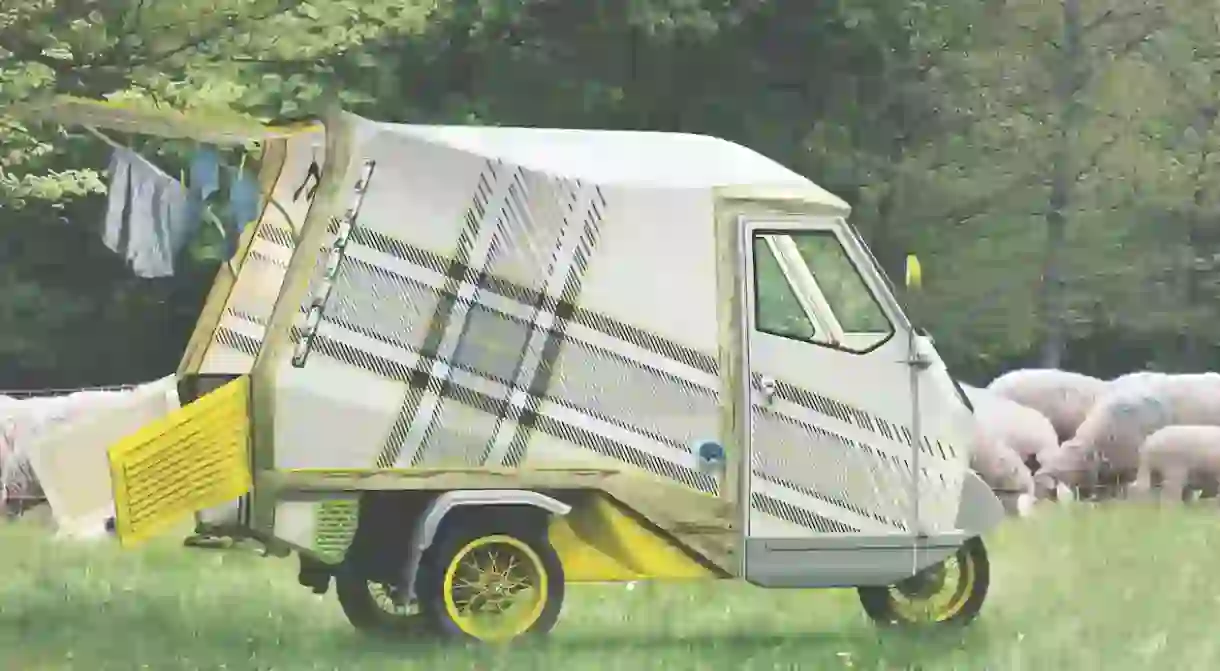New Book 'Mobitecture' Showcases Weird and Wonderful Portable Architecture

Ever wanted to travel around on a hut on wheels or stay in a hanging tent high up in the forest? Phaidon’s new title Mobitecture: Architecture on the Move explores mobile structures that go way beyond your average caravan to include those designed for deserts, oceans, beaches, mountains and cities that roll, inflate, pop up, slide on sleds or even float on water.
Portable designs have actually been around for thousands of years, from resilient Bedouin tents made of goat hair to protect against the harsh North African desert climate to the humble felt and timber yurt of Central Asia.
In more recent times, mobile architecture tends to take the familiar form of tents and caravans, giving us freedom from everyday routines and obligations. But it’s not just the desire to travel and explore that makes mobitecture part of our modern-day society, it’s also the pressure on cities, with architects constantly coming up with innovative solutions to alleviate that tension, but also refugees fleeing conflict zones and the homeless that require temporary shelter.
Weekend motor tricycle, Portugal
This was designed by Carlos No to highlight the improvised and unstable nature of shantytown dwellings and to magnify the plight of those in poverty. It’s just about large enough to stand up in, making it deliberately uncomfortable compared to the relative luxury of many people’s weekends away.

Pop-up caravan, The Netherlands
This caravan by design firm Tas-ka was one of the many unusual retail/exhibition spaces to pop up during the Hague’s Design Quarter Festival, that celebrated Dutch design.

Park bench bubble, UK
Designer Thor ter Kulve’s unusual design transforms a modest timber bench into a solo inflatable retreat with a solar-powered USB charger from which to work from. Made from scavenged materials, the project strips back the idea of ‘home’ to the essentials.

Nomad sauna, Norway
This sauna on skis was a collaborative project made by 20 students from the Survival Architecture Workshop and was conceived in response to the challenging climactic conditions of Lake Rossvatnet. There’s a chimney and storage for fuel, as well as a stove inside, and it can be pushed across a frozen lake in winter, while in the summer it reverts to a platform at the lake’s swimming beach for local community use.

Bike teardrop trailer, Canada
Innovative boat builder Matthew Hart designed this aerodynamic portable camper to attach to his bike as he cycled across British Columbia. The cosy timber-clad interior includes a folding table, fridge, sleeping space and mini cooker. It enabled Hart to enjoy life on the move, stopping in prime real-estate spots, or simply settling it down by parks or hilltops when he needed rest.

Camper Kart, USA
Artist Kevin Cyr transformed a steel shopping trolley into an autonomous home as an interesting experiment in mobile living. On a practical level, it includes storage for food and tools, a retractable sleeping deck and durable roof, but this project is also a social comment on the shopping trolley; this ubiquitous 1930s item has now come to be associated with the urban homeless.

8rad² solar cargo bike, Germany
This eco-friendly cargo bike designed by Nico Jungel is a radical alternative to fossil fuel powered vehicles. The largest sustainable version in the world, this cargo bike is carried on eight wheels and is steered and powered by two drivers. There’s also a solar-powered motor to assist if there’s only one driver.

Bufalino camper van, Germany
This cute little three-wheeled camper designed by Cornelius Comanns is well-suited to solo travel and acts as a kind of base camp that can travel alongside you on your adventures. It comes complete with a bed, fridge, storage for goods and water, plus areas for seating and cooking.

Author Rebecca Roke summarises the book: “Ranging from quirky to sensible and from rustic to deluxe, from houseboats, huts, and tricked-out caravans, to disaster shelters, wearables, and futuristic prototypes, Mobitecture vividly demonstrates the exciting possibilities for life on the move.”
The book is available to buy now – get your copy here.














